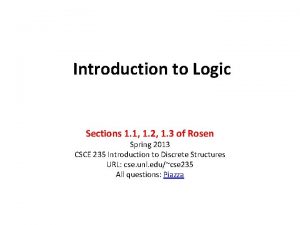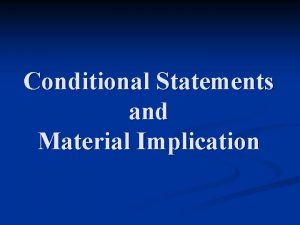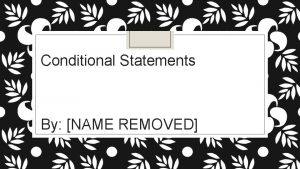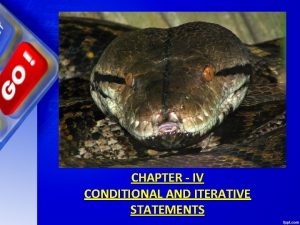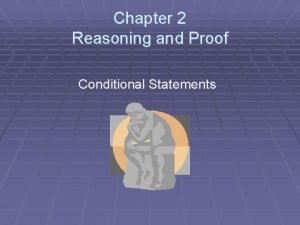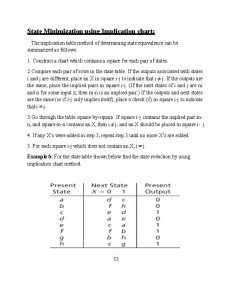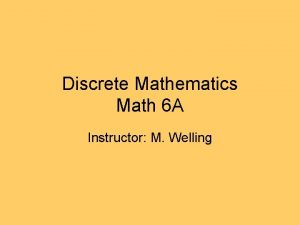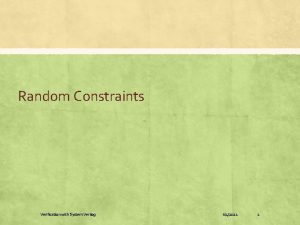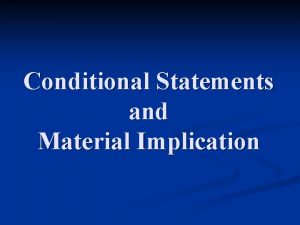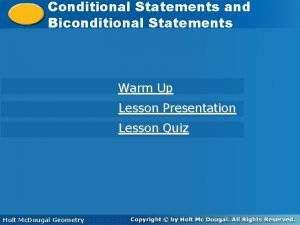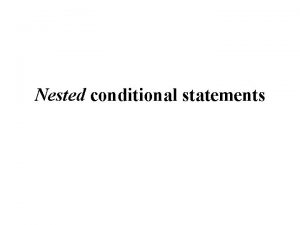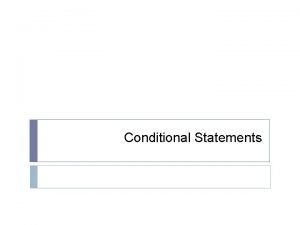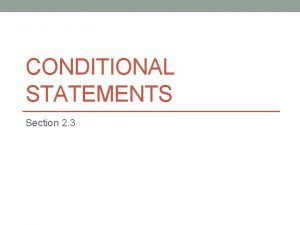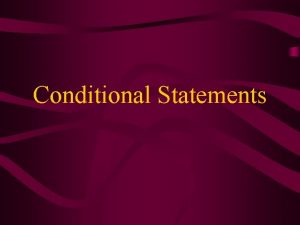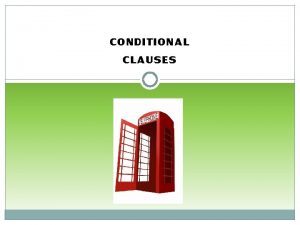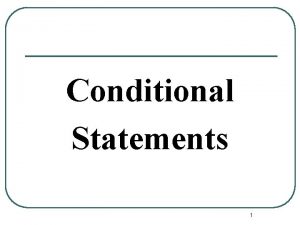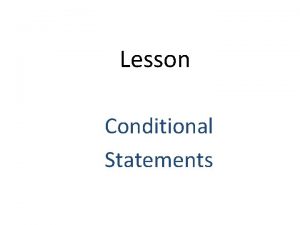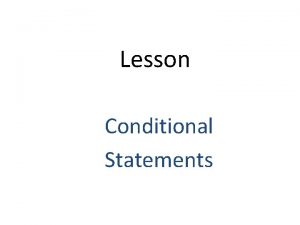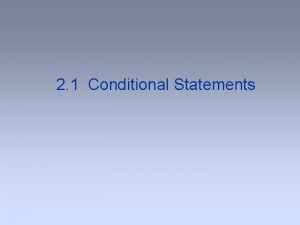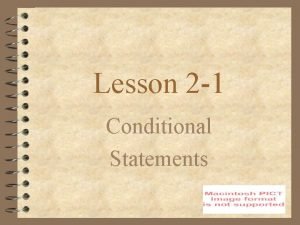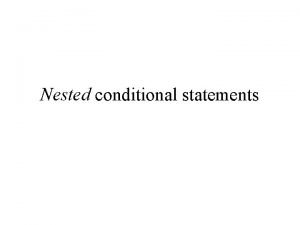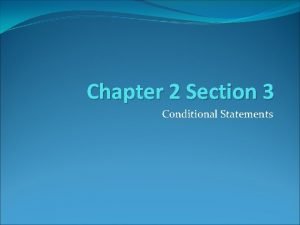Conditional Statements and Material Implication The Conditional The
















- Slides: 16

Conditional Statements and Material Implication

The Conditional: The Fourth Connective n Conditional statement: when two statements are combined by placing the word “if” before the first and “then” before the second n n ∩ n “If…then…” We use the arrow → or horseshoe to represent the “ifthen” phrase Also called a hypothetical, an implication, or an implicative statement The component statement that follows the “if” is called the antecedent The component statement that follows the “then” is called the consequent n If (antecedent), then (consequent)

The Conditional A conditional statement asserts that (in any case) if its antecedent is true, then its consequent is also true n But as in disjunction, there a few different senses in which a conditional can be interpreted n

The Four Types of Implication 1. If all humans are mortal and Socrates is a human, then Socrates is mortal. • Logical Implication: the consequent follows logically from its antecedent 2. If Leslie is a bachelor, then Leslie is unmarried. • Definitional Implication: the consequent follows the antecedent by definition 3. If I put X in acid, then X will turn red. • Causal Implication: The connection between antecedent and consequent is discovered empirically 4. Is we lose the game, then I’ll eat my hat. • Decisional Implication: no logical connection nor one by definition between the consequent and antecedent. This is a decision of the speaker to behave in the specified way under the specified circumstances.

Which Sense of Implication Do We Use? n We must try to find a sense that is at least a part of the meaning of all four different types of implication n No matter what type of implication is asserted by a conditional statement, part of its meaning is the negation of the conjunction of its antecedent with the negation of its consequent n For a conditional to be true (e. g. “If p then q”), ~(p • ~q) must be true: Think p=“A piece of blue litmus paper is placed in that solution. ” q=“The piece of blue litmus paper will turn red. ” “If p then q” = false if paper is placed in solution, but doesn’t turn red n n ∩ The horseshoe symbol does not stand, therefore, for all the meanings of “if-then” – there are several meanings p q abbreviates ~(p • ~q), whose meaning is included in the meanings of each kind of implication n

What this means… p q ~q p • ~q ~(p • ~q) T T F F T F F T

*Abbreviated Truth Table for the Conditional q T p T F F F T T F F T ∩ p T q T The only time a conditional is FALSE is when the antecedent is true and the consequent is false.

Material Implication ∩ n n n represents the material implication A fifth type of implication E. g. “If Hitler was a military genius, then I’m a monkey’s uncle. ” n No real connection between antecedent and consequent n n n This kind of relationship is what is meant by material implication It just asserts that it is not the case that the antecedent is true when the consequent is false. Many arguments contain conditional statements of various kinds of implication, but the validity of all valid arguments (of the general type with which we will be concerned) is preserved, even if the additional meanings of their conditional statements are ignored.

Some “If” Indicator Words n “If…” can be replaced by such phrases as: “in case…” n “provided that…” n “given that…” n “on condition that…” n n Some indicator words for “then…” include: “implies. . . ” n “entails…” n

Necessary Conditions n For a normal car to run, it is necessary that there is fuel in its tank, its spark plugs properly adjusted, its oil pump working, etc. n If the car runs, then every one of the conditions necessary for its occurrence must be fulfilled “That there is fuel in its tank is a necessary condition for the car to run” = “The car runs only if there is fuel in its tank” = “If the car runs then there is fuel in its tank” All these are “R ∩ n F”

Hints n “p is a necessary condition for q” ∩ =q p “…only if…” = “p only if q” = p ∩ n q

Sufficient Conditions n For a purse to contain over a dollar, it would be sufficient for it to contain 101 pennies, 21 nickels, 11 dimes, 5 quarters, etc. n n If any one of these circumstances obtains, the specified situation will be realized “That a purse contains 5 quarters is a sufficient condition for it to contain over a dollar” = “If the purse contains 5 quarters then it contains over a dollar”

Hints n “p is a sufficient condition for q” ∩ = p q (Note: here q is a necessary condition for p) n Compare: “p is a necessary condition for q” =q p (Note: here q is a sufficient condition for p) ∩ n ∩ “Formula” to help you remember, given any sentence saying something is a necessary or sufficient condition: n p Sufficient condition q Necessary condition

Example A, B, C are true statements X, Y, Z are false statements n Determine whether the following is true or false: n Y) ∩ (X ∩ n Z

Solution Y) ∩ (X ∩ n Z ∩ 1. Main connective is the second horseshoe (conditional) 2. Look at antecedent: (X Y): -X and Y are false, so this makes this conditional true -we know this by using our knowledge of the conditional (i. e. truth table for the material implication) 3. We know Z (the consequent) is also false 4. Therefore, a conditional with a true antecedent and

Example A, B, C are true statements X, Y, Z are false statements n Determine whether the following is true or false: n [(A X) • (X ∩ ∩ X)] ∩ ∩ [(A • X) v (~A A)]
 Symbol of negation
Symbol of negation Implication law
Implication law Material implication examples
Material implication examples 2-2 practice conditional statements
2-2 practice conditional statements Conditional and iterative statements
Conditional and iterative statements Proving conditional statements
Proving conditional statements Datum shift
Datum shift Examples of non material culture
Examples of non material culture Examples of non material culture
Examples of non material culture Material and non material culture examples
Material and non material culture examples Harmful and useful materials at home
Harmful and useful materials at home Implication table state minimization
Implication table state minimization Implication elimination
Implication elimination Proposition in discrete mathematics
Proposition in discrete mathematics Teaching implication of the information process
Teaching implication of the information process Verilog urandom
Verilog urandom Tautological implication
Tautological implication

